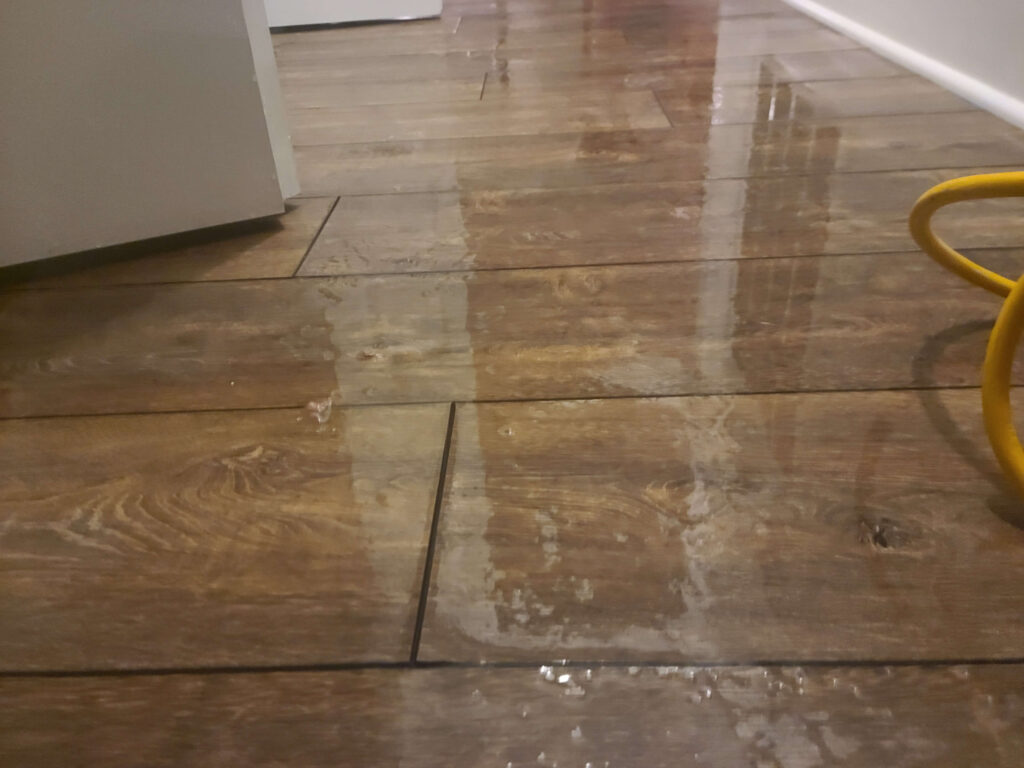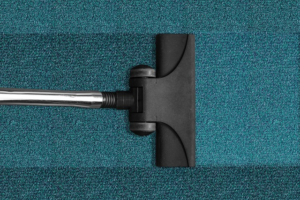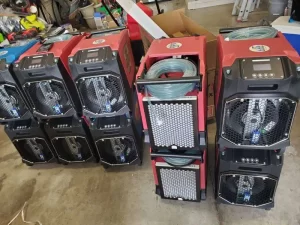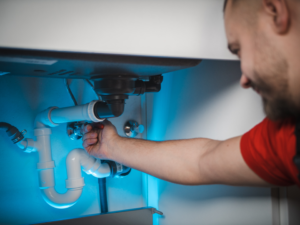Floods can be a nightmare, and many homeowners aren’t certain what to do after flood damage sweeps through their homes.
Flood Kings is here to help homeowners face the aftermath. Our IIRC-certified teams are experts in reclaiming, repairing, and restoring your home.
When it comes to the aftermath of a flood, you need to act quickly. Below, learn how to clean up after a flood to minimize damage to your home and wallet.
What to Do Immediately After a Flood
If you had to evacuate, you likely won’t be able to return home for a while. Keep an eye on alerts from first responders, emergency personnel, and your local government to know when you can return home.
- Shut off your gas and electricity: If you couldn’t do so during the evacuation, you need the gas and electricity in your home turned off. If there is any water around on the ground, don’t handle this yourself— call an electrician for help so they can use proper safety measures, and let your gas company turn off service.
- Document everything: Have a way to take pictures of your home and belongings, as you will need documentation for your insurance company. You can call them for any other instructions if you have a phone signal. If local authorities report a risk of flooding, you can call them in advance and take notes.
- Check your water quality: If you use well water, your priority should be testing to see if you can still drink from it unless you have a solid supply of bottled drinking water to hold you over.
- Call water restoration professionals: If you’re dealing with more than a couple of gallons of standing water, your best bet is to call professional help to get your property back in running order.
- Put in an insurance claim: Don’t procrastinate calling your insurance so you can get the ball rolling on repairs as soon as possible.
The Cleanup Process: How To Clean Your House After Flood Damage
It’s important that you don’t tackle water cleanup alone. Your home will likely sustain damage, and you could be putting your safety and your health at risk.
Call a water cleanup company in your area to help salvage what can be saved, inspect for structural damage, detect mold, and help you with repairs and restoration.
Once you and your crew are cleared to enter your house, flood damage restoration should look like this:
Always Wear Protective Gear
You will want rubber boots, rubber gloves, face masks, safety goggles, and clothes that you don’t mind throwing away.
Even if you have the company handle most of the work, you should always wear rubber boots in flooded areas. Flooded areas are often full of dangerous contaminants and harmful bacteria, thanks to raw sewage, dirt, and other debris.
You’re also at risk around the outside of your home, where nails and sharp debris are likely scattered on the ground.
Document Everything
Your insurance claim must include evidence of any loss and damage, including pictures and detailed subscriptions. Some homeowners go through their houses once every few years to document their belongings, but most don’t have the time.
Your cleanup and restoration company can help ensure everything is well-documented and advise on where to start.
If there is structural damage to your housekeeping you from entering, they can get photos during the inspection and provide descriptions for your insurance company without putting you or your family at risk.
Be Alert for Mold Growth
Mold growth can begin within one to two days of a flood, so if affected areas of your home have been damp for more than a couple of days, mold colonies have likely begun to form.
Mold and mildew can set in quickly and be harmful to breathe in, particularly black mold. Look for any ceiling and wall stains, dark water stains on wood, and other signs of growth.
Water damage restoration companies also work in mold remediation, so alert them to the issue immediately so they can remove mold as soon as possible.
Pump Out the Water
Before you can start working in your home, rent a sump pump to remove all standing water.
If it is safe to turn the power back on, a wet-dry vacuum can also help remove water, especially with any remaining standing water after the rest has been removed and with draining carpets.
Dry Out Your Home
Once you remove standing water, it’s time to focus on getting things dry. If it isn’t humid outdoors, open all your doors and windows.
If you have power or a generator with enough strength, fans, and humidifiers can help circulate more air and remove excess moisture, which helps speed up the drying process.
You shouldn’t turn your HVAC on until the ducts are inspected and cleaned by a licensed technician, or you risk further electrical damage to your house.

Remove Dirt, Debris, & Unsalvageable Belongings
Flood waters are notoriously nasty, filled with mud, silt, and debris from collateral flood damage. When looking through your water-soaked items in the flooded area, you’ll have two major categories: salvageable and not, and unfortunately, most items will be unsalvageable.
Materials like books, cardboard boxes, upholstered furniture, and other items that can’t survive water exposure must be thrown away. Solid wood furniture might survive water damage, depending on the intensity of the damage.
The CDC recommends not salvaging anything you cannot have dry within 24-48 hours of flooding due to the risk of mold.
Your local sanitation department will likely have instructions on what to do with any refuse and debris for proper disposal; if you don’t have a way to contact them, ask your cleanup company for advice.
Remove Damaged Drywall
If you have more than 10 square feet of water damage to your drywall, leave it to your water restoration professionals to handle.
But for smaller areas, you can punch it out after scoring the area with a utility knife. You’ll want to aim 15-24 inches above the water line on the walls.
If the insulation is wet, pull that out, too. Don’t replace anything until your home is dry, clean, and safe. For now, just leave the gaps there.
Please do not attempt to remove mold independently; seek professional help. Mold is very dangerous to work with and should be left to the experts.
Tackle Your Floors
Once your walls are safe and hopefully free of mold spores, it’s time to look at your flooring. Flood damage typically means you will need new flooring, so be ready to rip it all up and throw it away.
Even if they appear dry, surfaces like tile, laminate, and vinyl can have moisture and silt beneath them from the flood water. This leads to harmful bacteria, toxic substances like E.Coli and Salmonella, and mold growth. Carpet and carpet pads can be even worse.
Once again, don’t plan to replace anything yet. You need to wait for your cleanup contractor or a home inspector with flood water experience to give the all-clear.
Inspect Appliances and Countertops Thoroughly
Take care not to plug in or turn on any appliances during the cleanup process, as all electric units may be damaged or corroded from the flood waters, or even contain mold.
If any appliance was completely submerged, it will likely need to be disposed of for your safety per the CDC. If you think something is salvageable, have it inspected by your contractor before you give it power and try to use it.
Once you have the all-clear, you can use a water and bleach solution to clean the majority of nonporous, hard surfaces, like the metal or glass on appliances.
Clean All Hard Surfaces
You can use standard disinfectants, a bleach and water solution, or vinegar with water. If you use a chlorine bleach solution, be careful: bleach can be dangerous even when diluted.
Be sure not to inhale it and to protect your eyes and skin. A good mixture is a cup of bleach to one gallon of water.
Note: always wear gloves when handling bleach.
Salvage What You Can
Once your home is safe and free of excess water, you can turn to what belongings you didn’t have to throw away.
You will need to disinfect all salvageable items. Mix bleach and hot water, unmixed household disinfectant, or standard soapy water to ensure nothing survives that can harm your health.
Most household items are easy to wash, and your restoration company can help with harder or larger items like solid wood furniture.
Sanitize Everything
Make sure everything is sanitized of harmful contaminants from flood waters, including yourself and your safety gear. You should clean off your boots with disinfectant and wash your clothes in hot water.
Again, use any solution that makes you comfortable. Note: Never mix bleach with anything other than hot water to avoid creating a potentially hazardous concoction.
Once the cleanup process is complete, you will likely dispose of the clothing you worked in to ensure no harmful contaminants or mold spores survive in your newly cleaned home.
How To Protect Yourself From Future Water Damage
There are a few things you can do to minimize the impact future water damage events have on your life:
- Invest in a generator, sump pump, and wet-dry vac: a sump pump will help drain standing water from your home as it comes in, and a wet vacuum can quickly remove additional excess water, minimizing water damage to your home.
- Set up a humidity and moisture meter: A moisture meter measures moisture content in your flooring and subflooring so you’re quickly alerted to water leaks. A humidity meter, on the other hand, monitors the water vapor in your air, alerting you when conditions for mold arise.
- Keep your documents in waterproof, fireproof storage: Documents, photographs, and other artifacts are some of the most distressing belongings to lose during a water damage event. For maximum protection, store everything in secure plastic bags, ideally in a water and fire proof container.
- Keep emergency rations and extra doses of important medication: if you have a space that will likely be safe from flooding, like an attic, consider storing emergency rations and other supplies you can access once home. Try not to store things in your basement or garage in cardboard boxes; these attract pests and practically disintegrate when wet. Rubber containers are best, especially if they have a good seal.
Employing all of the tactics above softens the blow to you and your family if you do endure water damage from storms, heavy rains, or water leaks.
Caution: Always Heed Local Authorities’ Instructions
Damage from flooding can be a matter of public health. If your local emergency authorities give additional instructions, follow them to the letter.
If authorities tell you to leave the area again, do so. Floods can be stressful, and you, of course, want to save what you can in your home.
But cleaning up isn’t worth your or your family’s health and well-being. You may need to leave the entire area again if there is a risk of more water coming through or a major safety hazard like a live electrical line is discovered.
The sooner families leave to let emergency personnel work, the sooner they can finish and let everyone back in.
To Get Back On Your Feet ASAP, Call Flood Kings
If your house falls victim to water damage, don’t hesitate to call Flood Kings. We have been serving Nashville and the surrounding areas for fifteen years.
Our expert crews have the right tools for the job and the experience to use them well and will do everything in their power to help guide you through the cleanup process.
Middle Tennessee is our home, and we’re dedicated to helping our neighbors get through difficult times in their life so they can return to normal as quickly as possible.
Our lines are open 24/7. If you ever need our services— be it for floods, other water damage, sewage backup, or more — give us a call today.








